14.4 Doppler Effect and Sonic Booms
Learning Objectives
By the end of this section, you will be able to:
- Define Doppler effect, Doppler shift, and sonic boom.
- Calculate the frequency of a sound heard by someone observing Doppler shift.
- Describe the sounds produced by objects moving faster than the speed of sound.
The characteristic sound of a motorcycle buzzing by is an example of the Doppler effect. The high-pitch scream shifts dramatically to a lower-pitch roar as the motorcycle passes by a stationary observer. The closer the motorcycle brushes by, the more abrupt the shift. The faster the motorcycle moves, the greater the shift. We also hear this characteristic shift in frequency for passing race cars, airplanes, and trains. It is so familiar that it is used to imply motion and children often mimic it in play.
The Doppler effect is an alteration in the observed frequency of a sound due to motion of either the source or the observer. Although less familiar, this effect is easily noticed for a stationary source and moving observer. For example, if you ride a train past a stationary warning bell, you will hear the bell’s frequency shift from high to low as you pass by. The actual change in frequency due to relative motion of source and observer is called a Doppler shift. The Doppler effect and Doppler shift are named for the Austrian physicist and mathematician Christian Johann Doppler (1803–1853), who did experiments with both moving sources and moving observers. Doppler, for example, had musicians play on a moving open train car and also play standing next to the train tracks as a train passed by. Their music was observed both on and off the train, and changes in frequency were measured.
What causes the Doppler shift? Figure 14.13, Figure 14.14, and Figure 14.15 compare sound waves emitted by stationary and moving sources in a stationary air mass. Each disturbance spreads out spherically from the point where the sound was emitted. If the source is stationary, then all of the spheres representing the air compressions in the sound wave centered on the same point, and the stationary observers on either side see the same wavelength and frequency as emitted by the source, as in Figure 14.13. If the source is moving, as in Figure 14.14, then the situation is different. Each compression of the air moves out in a sphere from the point where it was emitted, but the point of emission moves. This moving emission point causes the air compressions to be closer together on one side and farther apart on the other. Thus, the wavelength is shorter in the direction the source is moving (on the right in Figure 14.14), and longer in the opposite direction (on the left in Figure 14.14). Finally, if the observers move, as in Figure 17.15, the frequency at which they receive the compressions changes. The observer moving toward the source receives them at a higher frequency, and the person moving away from the source receives them at a lower frequency.
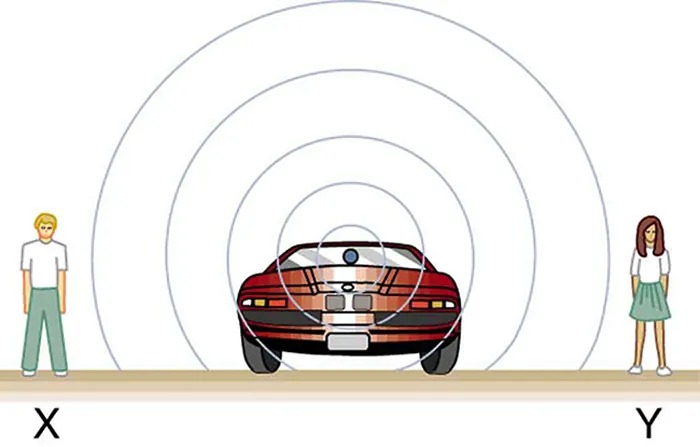
Figure 14.13 Sounds emitted by a source spread out in spherical waves. Because the source, observers, and air are stationary, the wavelength and frequency are the same in all directions and to all observers. Image from OpenStax College Physics 2e, CC-BY 4.0
Image Description
The image depicts a red car viewed from the rear, positioned on a flat surface. Around the car, several concentric circles are drawn, indicating the propagation of sound waves. On the left side of the car, a person labeled “X” is standing, while on the right side, another person labeled “Y” is standing. The circles suggest the difference in sound perception or intensity between the two individuals due to their positions relative to the car.
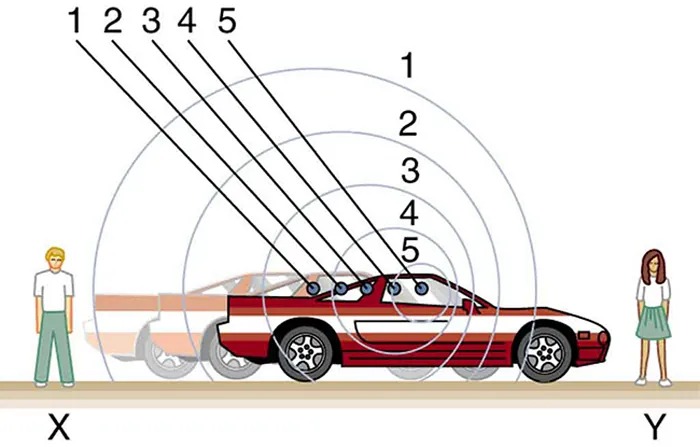
Figure 14.14 Sounds emitted by a source moving to the right spread out from the points at which they were emitted. The wavelength is reduced and, consequently, the frequency is increased in the direction of motion, so that the observer on the right hears a higher-pitch sound. The opposite is true for the observer on the left, where the wavelength is increased and the frequency is reduced. Image from OpenStax College Physics 2e, CC-BY 4.0
Image Description
The image depicts a red sports car moving from left to right across the image, with two people standing on either side of the path of the car. On the left side (labeled as “X”), there is a person standing facing the car with a neutral expression. On the right side (labeled as “Y”), another person stands facing the car with a neutral expression.
Above the car, there are five numbered lines (1 to 5) illustrating a series of concentric circles that increase in size, radiating from a pivot on the rear of the car. These circles are labeled from 1 to 5, representing the car’s positions as it moves from X to Y. Each position shows the car at a slightly forward point along its path.
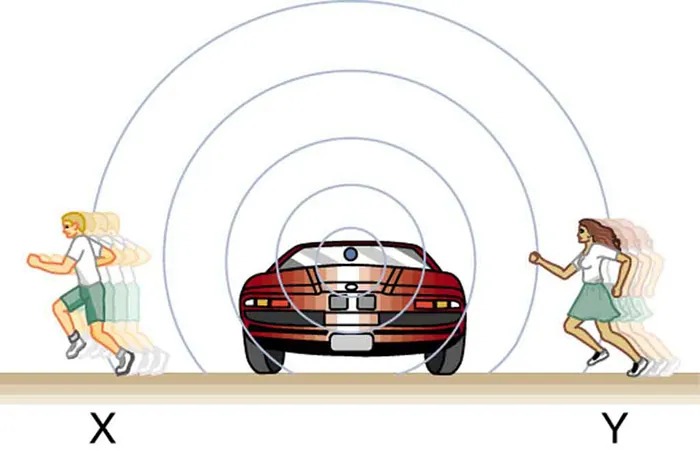
Figure 14.15 The same effect is produced when the observers move relative to the source. Motion toward the source increases frequency as the observer on the right passes through more wave crests than she would if stationary. Motion away from the source decreases frequency as the observer on the left passes through fewer wave crests than he would if stationary. Image from OpenStax College Physics 2e, CC-BY 4.0
Image Description
The image illustrates a visual representation of the Doppler effect using a scenario with a car and two people. At the center, there is a red car emitting circular waves, which represent sound waves. On the left side, labeled “X,” there is a person running towards the car, shown with multiple faint outlines to indicate motion. On the right side, labeled “Y,” there is another person running away from the car, also depicted with multiple faint outlines to show movement. The waves appear compressed on the left side and elongated on the right side, demonstrating the change in frequency perceived by the two individuals due to their motion relative to the sound source.
We know that wavelength and frequency are related by [latex]v_{w} = fλ[/latex], where [latex]v_{w}[/latex] is the fixed speed of sound. The sound moves in a medium and has the same speed [latex]v_{w}[/latex] in that medium whether the source is moving or not. Thus [latex]f[/latex] multiplied by [latex]\lambda[/latex] is a constant. Because the observer on the right in Figure 14.14 receives a shorter wavelength, the frequency she receives must be higher. Similarly, the observer on the left receives a longer wavelength, and hence he hears a lower frequency. The same thing happens in Figure 14.15. A higher frequency is received by the observer moving toward the source, and a lower frequency is received by an observer moving away from the source. In general, then, relative motion of source and observer toward one another increases the received frequency. Relative motion apart decreases frequency. The greater the relative speed is, the greater the effect.
The Doppler Effect
The Doppler effect occurs not only for sound but for any wave when there is relative motion between the observer and the source. There are Doppler shifts in the frequency of sound, light, and water waves, for example. Doppler shifts can be used to determine velocity, such as when ultrasound is reflected from blood in a medical diagnostic. The recession of galaxies is determined by the shift in the frequencies of light received from them and has implied much about the origins of the universe. Modern physics has been profoundly affected by observations of Doppler shifts.
For a stationary observer and a moving source, the frequency fobs received by the observer can be shown to be
[latex]f_{\text{obs}} = f_{s} \left(\frac{v_{w}}{v_{w} \pm v_{s}}\right) ,[/latex]
where [latex]f_{s}[/latex] is the frequency of the source, [latex]v_{s}[/latex] is the speed of the source along a line joining the source and observer, and [latex]v_{w}[/latex] is the speed of sound. The minus sign is used for motion toward the observer and the plus sign for motion away from the observer, producing the appropriate shifts up and down in frequency. Note that the greater the speed of the source, the greater the effect. Similarly, for a stationary source and moving observer, the frequency received by the observer [latex]f_{\text{obs}}[/latex] is given by
[latex]f_{\text{obs}} = f_{s} \left(\frac{v_{w} \pm v_{\text{obs}}}{v_{w}}\right) ,[/latex]
where [latex]v_{\text{obs}}[/latex] is the speed of the observer along a line joining the source and observer. Here the plus sign is for motion toward the source, and the minus is for motion away from the source.
Example 14.4
Calculate Doppler Shift: A Train Horn
Suppose a train that has a 150-Hz horn is moving at 35.0 m/s in still air on a day when the speed of sound is 340 m/s.
(a) What frequencies are observed by a stationary person at the side of the tracks as the train approaches and after it passes?
(b) What frequency is observed by the train’s engineer traveling on the train?
Strategy
To find the observed frequency in (a), [latex]f_{\text{obs}} = f_{s} \left(\frac{v_{w}}{v_{w} \pm v_{s}}\right) ,[/latex] must be used because the source is moving. The minus sign is used for the approaching train, and the plus sign for the receding train. In (b), there are two Doppler shifts—one for a moving source and the other for a moving observer.
Solution for (a)
(1) Enter known values into [latex]f_{\text{obs}} = f_{s} \left(\frac{v_{w}}{v_{w} – v_{s}}\right) .[/latex]
[latex]\begin{align*}f_{\text{obs}} &= f_{s} \left(\frac{v_{w}}{v_{w} - v_{s}}\right)\\ &= \left(\text{150 Hz}\right) \left(\frac{\text{340 m}/\text{s}}{\text{340 m}/\text{s }–\text{ 35}.\text{0 m}/\text{s}}\right)\end{align*}[/latex]
(2) Calculate the frequency observed by a stationary person as the train approaches.
[latex]f_{obs} = \left(\right. \text{150 Hz} \left.\right) \left(\right. \text{1}.\text{11} \left.\right) = \text{167 Hz}[/latex]
(3) Use the same equation with the plus sign to find the frequency heard by a stationary person as the train recedes.
[latex]\begin{align*}f_{\text{obs}} &= f_{s} \left(\frac{v_{w}}{v_{w} + v_{s}}\right)\\ &= \left(\text{150 Hz}\right) \left(\frac{\text{340 m}/\text{s}}{\text{340 m}/\text{s} + \text{35}.\text{0 m}/\text{s}}\right)\end{align*}[/latex]
(4) Calculate the second frequency.
[latex]f_{obs} = \left(\right. \text{150 Hz} \left.\right) \left(\right. 0.907 \left.\right) = \text{136 Hz}[/latex]
Discussion on (a)
The numbers calculated are valid when the train is far enough away that the motion is nearly along the line joining train and observer. In both cases, the shift is significant and easily noticed. Note that the shift is 17.0 Hz for motion toward and 14.0 Hz for motion away. The shifts are not symmetric.
Solution for (b)
(1) Identify knowns:
- It seems reasonable that the engineer would receive the same frequency as emitted by the horn, because the relative velocity between them is zero.
- Relative to the medium (air), the speeds are [latex]v_{s} = v_{\text{obs}} = 35.0 m/s.[/latex]
- The first Doppler shift is for the moving observer; the second is for the moving source.
(2) Use the following equation:
[latex]f_{\text{obs}} = \left[\right. f_{s} \left(\frac{v_{w} \pm v_{\text{obs}}}{v_{w}}\right) \left]\right. \left(\frac{v_{w}}{v_{w} \pm v_{s}}\right) .[/latex]
The quantity in the square brackets is the Doppler-shifted frequency due to a moving observer. The factor on the right is the effect of the moving source.
(3) Because the train engineer is moving in the direction toward the horn, we must use the plus sign for [latex]v_{obs} ;[/latex] however, because the horn is also moving in the direction away from the engineer, we also use the plus sign for [latex]v_{s}[/latex]. But the train is carrying both the engineer and the horn at the same velocity, so [latex]v_{s} = v_{obs}[/latex]. As a result, everything but [latex]f_{s}[/latex] cancels, yielding
[latex]f_{\text{obs}} \text{ }=\text{ } f_{s} .[/latex]
Discussion for (b)
We may expect that there is no change in frequency when source and observer move together because it fits your experience. For example, there is no Doppler shift in the frequency of conversations between driver and passenger on a motorcycle. People talking when a wind moves the air between them also observe no Doppler shift in their conversation. The crucial point is that source and observer are not moving relative to each other.
Sonic Booms to Bow Wakes
What happens to the sound produced by a moving source, such as a jet airplane, that approaches or even exceeds the speed of sound? The answer to this question applies not only to sound but to all other waves as well.
Suppose a jet airplane is coming nearly straight at you, emitting a sound of frequency [latex]f_{s}[/latex]. The greater the plane’s speed [latex]v_{s}[/latex], the greater the Doppler shift and the greater the value observed for [latex]f_{\text{obs}}[/latex]. Now, as [latex]v_{s}[/latex] approaches the speed of sound, [latex]f_{\text{obs}}[/latex] approaches infinity, because the denominator in
[latex]f_{\text{obs}} = f_{s} \left(\frac{v_{w}}{v_{w} \pm v_{s}}\right)[/latex] approaches zero. At the speed of sound, this result means that in front of the source, each successive wave is superimposed on the previous one because the source moves forward at the speed of sound. The observer gets them all at the same instant, and so the frequency is infinite. (Before airplanes exceeded the speed of sound, some people argued it would be impossible because such constructive superposition would produce pressures great enough to destroy the airplane.) If the source exceeds the speed of sound, no sound is received by the observer until the source has passed, so that the sounds from the approaching source are mixed with those from it when receding. This mixing appears messy, but something interesting happens—a sonic boom is created. (See Figure 14.16.)
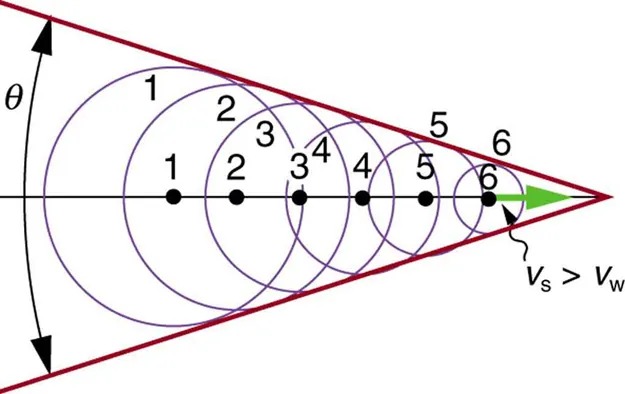
Figure 14.16 Sound waves from a source that moves faster than the speed of sound spread spherically from the point where they are emitted, but the source moves ahead of each. Constructive interference along the lines shown (actually a cone in three dimensions) creates a shock wave called a sonic boom. The faster the speed of the source, the smaller the angle [latex]\theta[/latex]. Image from OpenStax College Physics 2e, CC-BY 4.0
Image Description
This image illustrates the concept of a sonic boom using the visual of a circular wavefront pattern. A series of six black dots are placed in a straight line on a horizontal axis, each labeled with numbers from 1 to 6. Around each dot, there are semicircles formed by purple lines that represent sound waves emanating from each point. The semicircles become smaller and more compressed towards the right, indicating movement.
A triangular shape formed by red lines encompasses the wavefronts and points to the right, with its tip near a small green triangle. This overall triangular shape signifies the Mach cone, with the angle within the triangle labeled with the Greek letter theta (θ). An arrow points to the right, indicating the direction of movement, while text beside it states “vs > vw,” indicating that the speed of the source (vs) is greater than the speed of sound in that medium (vw).
There is constructive interference along the lines shown (a cone in three dimensions) from similar sound waves arriving there simultaneously. This superposition forms a disturbance called a sonic boom, a constructive interference of sound created by an object moving faster than sound. Inside the cone, the interference is mostly destructive, and so the sound intensity there is much less than on the shock wave. An aircraft creates two sonic booms, one from its nose and one from its tail. (See Figure 14.17.) During television coverage of space shuttle landings, two distinct booms could often be heard. These were separated by exactly the time it would take the shuttle to pass by a point. Observers on the ground often do not see the aircraft creating the sonic boom, because it has passed by before the shock wave reaches them, as seen in Figure 14.17. If the aircraft flies close by at low altitude, pressures in the sonic boom can be destructive and break windows as well as rattle nerves. Because of how destructive sonic booms can be, supersonic flights are banned over populated areas of the United States.
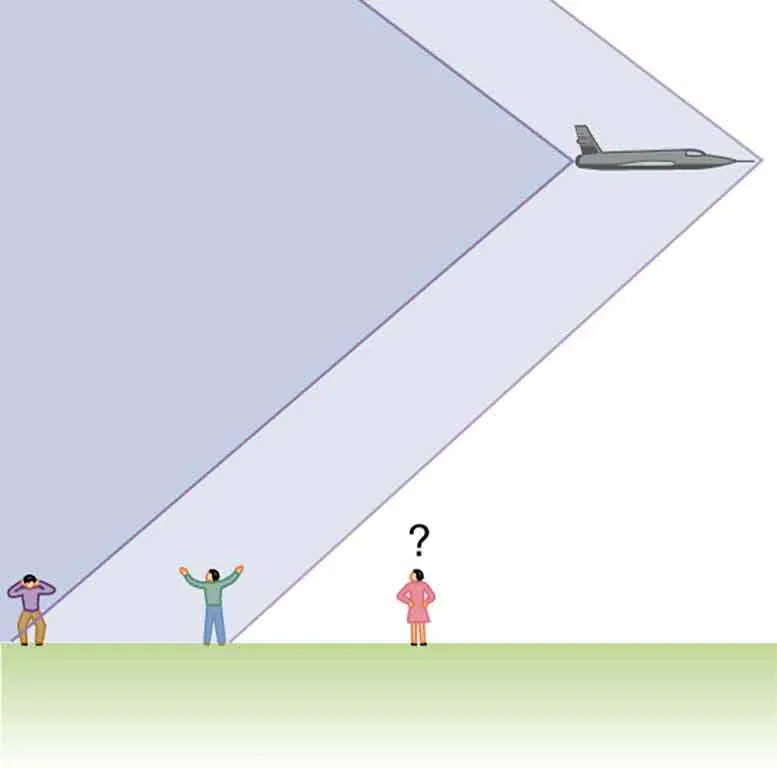
Figure 14.17 Two sonic booms, created by the nose and tail of an aircraft, are observed on the ground after the plane has passed by. Image from OpenStax College Physics 2e, CC-BY 4.0
Image Description
The image is a conceptual illustration depicting a fighter jet flying at an angle over the horizon. It creates a large triangular shadow across the ground. In the foreground, three small figures are shown on a green surface: one is holding hands up to their ears, another has their arms raised, and the third is standing with a question mark above their head, indicating confusion. The large triangular shadow covers part of the ground where these figures stand, illustrating the concept of sound waves or sonic boom created by the jet.
Sonic booms are one example of a broader phenomenon called bow wakes. A bow wake, such as the one in Figure 14.18, is created when the wave source moves faster than the wave propagation speed. Water waves spread out in circles from the point where created, and the bow wake is the familiar V-shaped wake trailing the source. A more exotic bow wake is created when a subatomic particle travels through a medium faster than the speed of light travels in that medium. (In a vacuum, the maximum speed of light will be [latex]c = 3 . \text{00} \times \text{10}^{8} \text{m}/\text{s}[/latex]; in the medium of water, the speed of light is closer to [latex]0.75 c[/latex]. If the particle creates light in its passage, that light spreads on a cone with an angle indicative of the speed of the particle, as illustrated in Figure 14.19. Such a bow wake is called Cerenkov radiation and is commonly observed in particle physics.

Figure 14.18 Bow wake created by a duck. Constructive interference produces the rather structured wake, while there is relatively little wave action inside the wake, where interference is mostly destructive. Image from OpenStax College Physics 2e, CC-BY 4.0
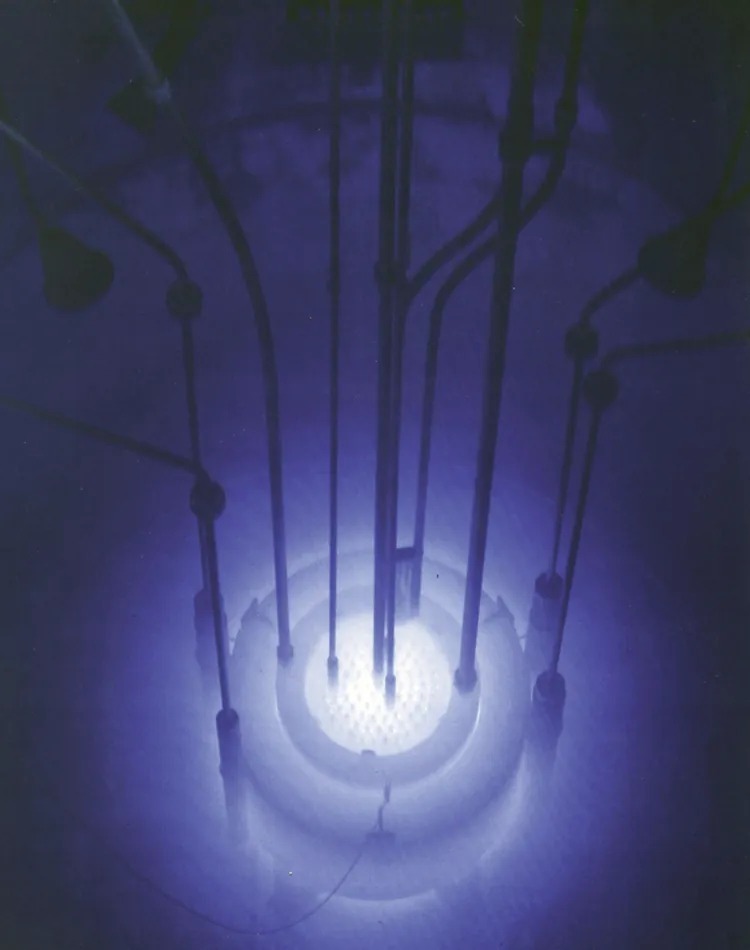
Doppler shifts and sonic booms are interesting sound phenomena that occur in all types of waves. They can be of considerable use. For example, the Doppler shift in ultrasound can be used to measure blood velocity, while police use the Doppler shift in radar (a microwave) to measure car velocities. In meteorology, the Doppler shift is used to track the motion of storm clouds; such “Doppler Radar” can give velocity and direction and rain or snow potential of imposing weather fronts. In astronomy, we can examine the light emitted from distant galaxies and determine their speed relative to ours. As galaxies move away from us, their light is shifted to a lower frequency, and so to a longer wavelength—the so-called red shift. Such information from galaxies far, far away has allowed us to estimate the age of the universe (from the Big Bang) as about 14 billion years.
Check Your Understanding
Why did scientist Christian Doppler observe musicians both on a moving train and also from a stationary point not on the train?
Click for Solution
Solution
Doppler needed to compare the perception of sound when the observer is stationary and the sound source moves, as well as when the sound source and the observer are both in motion.
Check Your Understanding
Describe a situation in your life when you might rely on the Doppler shift to help you either while driving a car or walking near traffic.
Click for Solution
Solution
If I am driving and I hear Doppler shift in an ambulance siren, I would be able to tell when it was getting closer and also if it has passed by. This would help me to know whether I needed to pull over and let the ambulance through.

